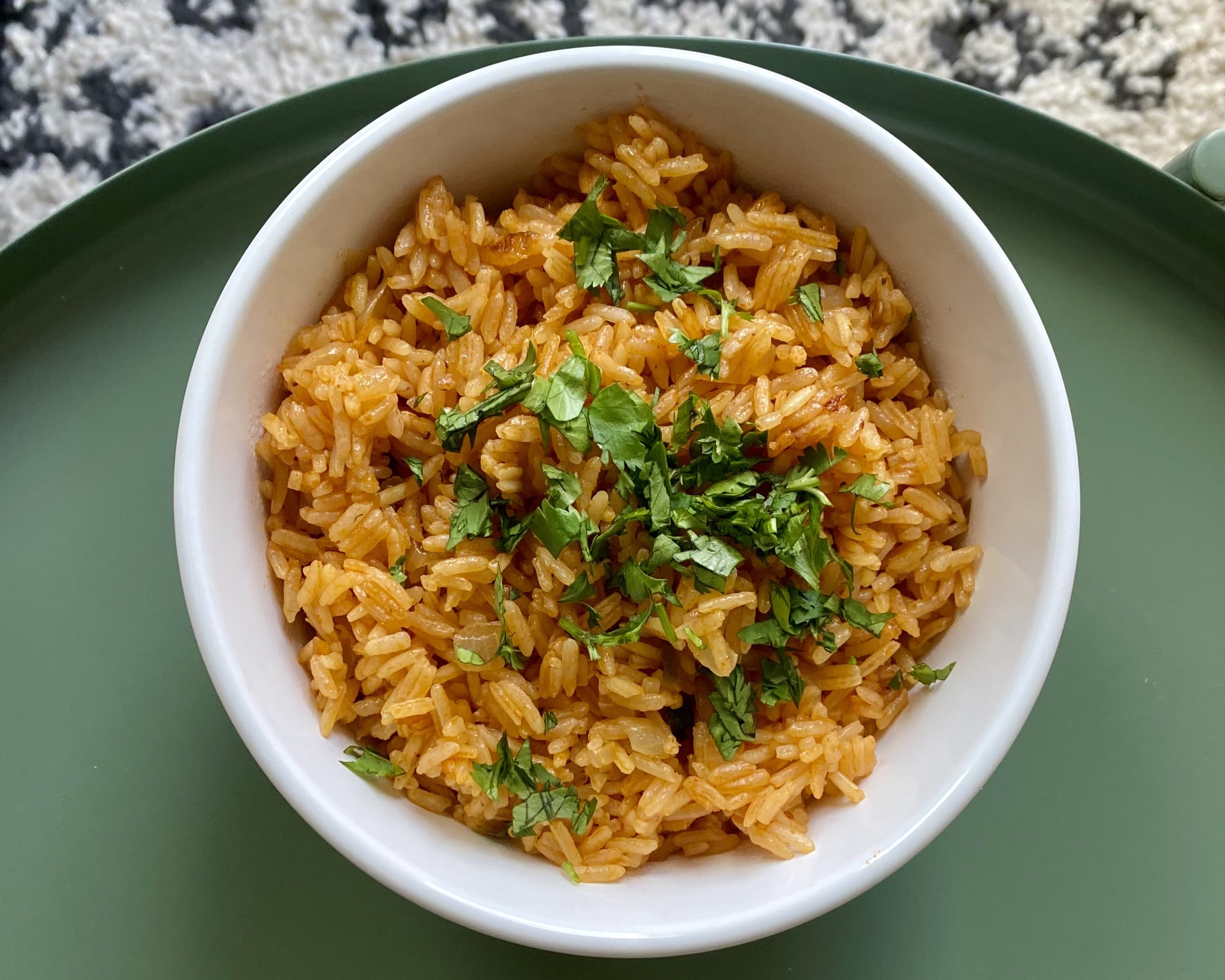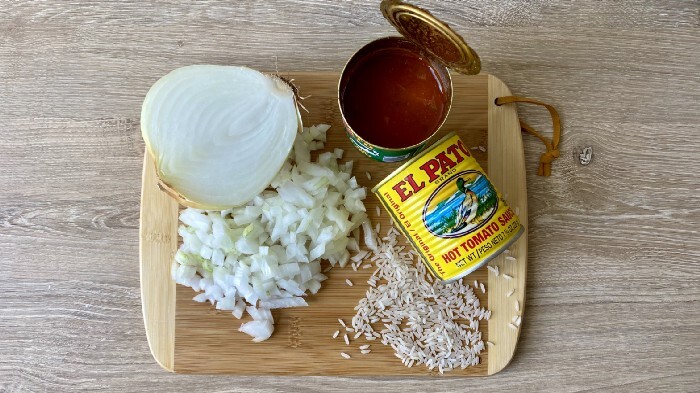
Historias de la Cocina: Arroz Rojo (Spanish Rice)
The tomato and onion spiced dish is rooted in colonization and oral tradition.
Arguably the best part of any Mexican meal is the heap of Spanish rice, alongside a mound of cheesy, refried beans. This orange-hued aromatic rice is known in northern Mexico (and by Mexican American families, affectionately) as arroz or arroz rojo.
For Mexican Americans, arroz is perhaps the most beloved side dish. The simple ingredients make it accessible and easy to batch-cook once you learn the process. Arroz brings to mind large family gatherings with mounds of rice, beans and carne asada in huge aluminum trays, ready for serving. As a child who grew up in The Valley of Southern California, I ate it with nearly every meal. For dinners, arroz con frijoles, or rice and beans, were a given.
This quintessential Mexican side dish, as many Mexican dishes, is a product of Spanish colonization. Not native to Mexico, rice as a crop was introduced as early as the 1500s. Mari-Jose Amerlinck — a professor of Regional Culture at the University of Guadalajara — detailed the history and importance of rice to Mexico in Rice and Beans: A Unique Dish in a Hundred Places. Rice originally came to Mexico from Asia — first by way of Arabic civilizations (which also influenced Mexican foods like escabeche and al pastor) and later through Caribbean islands and Spanish trading networks, according to Amerlinck. Additionally, influence from enslaved Black people and Moorish immigrants in Mexico, who were already accustomed to rice at the time of its introduction to the country, should be taken into account in the creation of the dish we now call Spanish rice, Amerlinck wrote.
Little is known on the particulars of how rice became such an important part of the Mexican diet. What is known, however, is that the tomato and onion spiced variation is actually part of a regional Mexican cuisine. Amerlink says that many Mexican culinary traditions — especially as they pertain to rice — have drawn their influence from local, popular and regional roots which have gone through a process of gentrification over the centuries. Amerlinck suggests that Spanish rice has evolved to its current form due to a search for certain dishes to gain more popular global acclaim. The well-loved orange iteration of arroz is found mostly in Northern Mexico and the Southwestern United States. Arroz blanco, or white rice, is more common in Southern Mexico.
Much of my family immigrated from Guadalajara — a habitat of the typical arroz rojo — and settled in parts of New Mexico and Southern California some generations ago. Learning the dish is something of a family tradition, passed down by the women in my family. And I might be biased, but no one makes it better than my grandmother.
My abuela is the designated rice maker for all of our family functions. No one can quite match the perfect fall-apart texture of her rice. The grains never stick together, as though each one was carefully coated in tomato sauce and cooked individually. Part of the flawless texture has to do with the pan she cooks it in — a shallow ceramic pot, only about an inch deep. But of course, the pan alone is not the golden ticket to mastering arroz rojo. Watching my grandmother make it is like watching a master seamstress sew a hem. She doesn’t measure. She doesn’t set a timer. She browns rice, onions, and garlic, and knows exactly the moment when cooked rice goes from underdone to perfect with a precision that may only be bestowed upon Latina grandmothers.
Over the phone, my abuela recounted her first experience cooking arroz. One day, when she was still a child, her grandmother asked her to watch over the pot, imploring her not to let the grains burn. “So there I am, ten years old, stirring the rice. And it started to look real pretty,” she said. “I saw it changing colors from white to golden, and I said ‘I gotta learn how to make this stuff.’”
When I moved from Southern California to New York for college, I called my mom and my grandma — almost on a weekly basis — from my tiny dorm kitchen to ask them how to make arroz. I remember the string of non-specific instructions; their explanations on how to make it were practically useless. The recipe lived in their heads and in their bodies, they just knew how to do it.
“Just brown the onions, garlic and rice until they look done,” my grandmother would say, “then just add the tomato sauce, water and bouillon. Put the lid on and it’ll be done, oh, in maybe 20 minutes or so.” But without fail, nearly every time, I turned the bottom of my pot into an inedible, blackened rice cracker. Even when I followed the directions exactly, it was impossible to recreate my grandma’s fluffy marigold-hued side dish.
Fast-forward some five years after those panicked weeknight phone calls over a burnt pot of arroz, and I have finally mastered the recipe. My rice now turns out as fluffy and vibrant as pots my grandma has cooked for me before. The grains no longer stick together in a tomato-y clump, but fall apart easily, flavored with all of the Mexican necessities — onions, garlic and tomatoes.
I tested the recipe that was handed down to me for over four years, and I found that using a medium to long grain rice yields the best results. Browning the rice properly in the beginning is the key to that fall-apart texture — it will ensure that the grains don’t stick together. It does take time and practice to get the water, heat, and timing all perfectly in balance, so first time arroz makers, don’t be afraid to stir the rice at around the 15 minute mark to ensure it does not burn. Of course, don’t worry if the bottom gets a little bit crispy the first few times. After a couple of tries, you just might start to feel the recipe in your head and body the way the women in my family have for generations.

Photo by Jae Thomas.
Ingredients
- 2 tbsp. Canola oil or other cooking oil
- 2 cups white rice
- ½ medium onion, diced
- 2 tsp. garlic, minced
- ½ cup Pato Sauce or regular tomato sauce
- 2 ¼ cups water*
- 1 cube Caldo de Pollo (chicken soup) bouillon* (or the equivalent chicken bouillon powder)
*You can also use broth in place of the water and chicken bouillon cube. Use 2 ¼ cups of chicken or vegetable broth with salt and garlic powder to taste, about 2 tsp. of each.
Preparation
Step 1
Heat oil in a large pot over medium-high heat for about 1 minute. Once oil is very hot and shimmering slightly, pour in rice, stirring occasionally until grains begin to turn golden brown, about 4-5 minutes.
Step 2
Add in onions, stirring occasionally, until they just begin to turn translucent, 1-2 minutes. Add garlic, stirring to combine with onions and rice. Let cook for about 30 seconds until the garlic begins to turn golden brown.
Step 3
Turn heat down to medium-low. Add in tomato sauce of choice, mixing to coat the rice evenly. Cook tomato sauce down for one minute. Pour in water, immediately stirring to break up any clumps of rice. Break up one chicken bouillon cube with your fingers and stir into the rice until it is mostly dissolved.
Step 4
Bring mixture to boil, stirring once again to get rid of any clumps of rice. This will ensure rice does not stick to the bottom of the pan. Turn heat down to low. Cover. Cook with the lid on for 20-23 minutes, or until rice is soft and fluffy and the grains easily fall apart.


